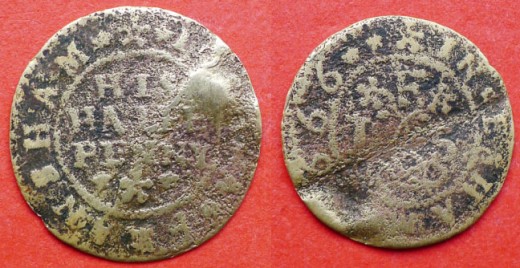
17th century token found at Wickhamford
This brass token, found in Wickhamford, was issued by Joshua Fransham in 1666. The picture shows both sides of the token. On the left it says 'JOSHUA FRANSHAM HIS HALFE PENNY' and on the right 'IN EVESHAM 1666 F J S'.
Traders' tokens were issued from the year 1648, towards the close of the reign of Charles I, until the year 1672, when they were cried down by proclamation of Charles II, and a new copper currency issued, the first we had in England, all previously being Royal tokens. During the Commonwealth they were not numerous, but after the Restoration, in 1660, to the year 1672 they were exceedingly abundant and were issued in nearly every town and village in England. They were issued without authority, no doubt, as many of them state, for necessary change. In London alone nearly 4000 were issued and the remainder of England are estimated at 15,000 more. In the year 1669 (when this kind of coinage was first checked) the citizens of Norwich had a pardon granted them for all transgressions, and in particular for their coinage of halfpence and farthings, by which they had forfeited their charter, all coinage being declared to be the King's prerogative; and in 1670 Worcester Corporation petitioned his Majesty's pardon for "putting out farthings in this city".
Note, the letters VE are missing out of EVESHAM on this token and half is spelled HALFE. This particular token has been mentioned by several authors in the various local publications e.g. Edward Rudge in 'A short account of the history and antiquities of Evesham (1820). The Rudge family had one in their collection. John Noake also mentions this token in his 'Notes and Queries for Worcestershire'. He in fact gives the inscription as 'IN E[8]SHAM 1666' - obviously a worn specimen and the letter S looking like the figure 8.
Our thanks are due to Peter Bastow for bringing his find to Tom Locke's attention and Peter Stewart for identifying the token and producing these notes.
For more on archaeology in the Badsey area see this article.
